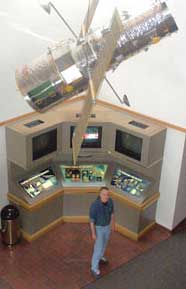A Star Too Big To Even Make A Black Hole
Wow…you actually can be too big to make a black hole…
In a cascade of superlatives that belies the traditional cerebral reserve of their profession, astronomers reported yesterday that they had seen the brightest and most powerful stellar explosion ever recorded.
The cataclysm — a monster more than a hundred times as energetic as the typical supernova in which the more massive stars end their lives — may be an example, they said, of a completely new type of explosion. Such a blast, proposed but never seen, would explain how the earliest and most massive stars in the universe ended their lives and strewed new elements across space to fertilize future stars and planets.
The star in question wasn’t on the fringe of what we can see, toward the beginning of time, but "only" about 240 million light years away.
Astronomers have been following the star since last September, when it was discovered in a galaxy 240 million light-years away in the constellation Perseus. The discovery was made by Robert Quimby, a University of Texas graduate student, who was using a small robotic telescope at McDonald Observatory near Fort Davis, Tex., to troll for supernovas.
The star bears an eerie resemblance to Eta Carinae, a star in our own galaxy that has been burbling and bubbling in the last few centuries as if getting ready for its own outburst. The observations suggest that the troubled and enigmatic Eta Carinae, thought to weigh in at about 120 solar masses, could blow up sooner than theorists have thought. Mario Livio, a theorist at the Space Telescope Science Institute…
Hey…I work there!
…who was not involved in the research, said Eta Carinae’s death could be “the most spectacular star show in history.”
They are still haggling over what happened to cause such a massive blast, but they have an interesting idea. The star was so big, that it created matter/antimatter pairs. Specifically, electrons and positrons…
Supernovas come about in two basic ways: explosions of small stars about one and half times the mass of the Sun, which are known as white dwarfs and are uniform enough to serve as cosmological distance markers; and the collapse of the cores of more massive stars into black holes or neutron stars when their thermonuclear fuel has run out.
The astronomers first suspected that the supernova’s dramatic output was caused by the shock wave of a white dwarf exploding into a dense cloud of hydrogen. When observations with the Chandra X-ray Observatory failed to find enough X-rays to support that idea, the group was forced to consider an alternative: that the luminosity was produced by the decay of radioactive nickel. But to match the observations, the star would have had to produce 22 solar masses of radioactive nickel — way off scale for the core collapse model.
In desperation, the astronomers turned to a theory proposed nearly 40 years ago by Zalman Barkat of the Hebrew University of Jerusalem and his colleagues. The intensity of radiation in the cores of supermassive stars could be so great, they said, that pairs of electrons and their antimatter opposites, positrons, would be created.
“That is bad news for the star,” Dr. Livio said, explaining that the disappearance of the radiation would sap the core’s energy and cause the star to collapse. But in this case the star still has plenty of fuel and blows up.
“The core is still composed of explosive oxygen,” explained another of the paper’s authors, J. Craig Wheeler of the University of Texas. “The oxygen ignites and blows the star to smithereens with no remnant, no black hole left.”
Too big to make a black hole…or anything else! Damn. It just blows itself apart. Damn!
The thinking is that there were a lot of these super massive stars around back near the beginning of time. The stars back then, they think, got really, really big. But so big, they figured, that most of the heavier elements they made had to be trapped in the resulting black hole at the end of their lives. And yet astronomers see a lot of heavy elements in the light from those distances. A lot more of it then they’d expected to. So something had to be seeding the early universe with it. Maybe this is what was doing that. Maybe there is an upper limit to how big a star can be in order to make a black hole, and maybe those early super massive stars at the beginning of time didn’t actually make any. Instead they started making antimatter at some point and blew themselves apart before they’d even exhausted their fuel.
Some really neat animations of the explosion, one an artist’s conception of how the explosion took place, and the other from actual observations, first from the PAIRITEL telescope, then an infrared adaptive optics image from Lick Observatory, then Chandra imagery, over at the Chandra project Here.







































